Hyperrhiz 21
Teaching Critical Memes
Leonardo Flores
Appalachian State University
Citation: Flores, Leonardo. “Teaching Critical Memes.” Hyperrhiz: New Media Cultures, no. 21, 2019. doi:10.20415/hyp/021.t02
Abstract: The goal of this lesson is to repurpose a popular digital media genre, the Internet meme, as a vehicle for critical analysis of a literary (or other kind of) text. This way, students can express their insights on a topic or work in a format that they already read, create, remix, and share.
This article focuses on the image macro format, which in its most popular form consists of captions in uppercase Impact font over an image (usually square), along with a conceptual or verbal pattern (see figure 1 for an example). While memes can take other formats, the image macro has become the most widely used, to the extent that in common parlance “meme” refers to image macro and other formats that aspire to reach widespread circulation on the Internet.
Keywords: pedagogy, theory, memes, image macros, criticism, hashtags.
Teaching Critical Memes
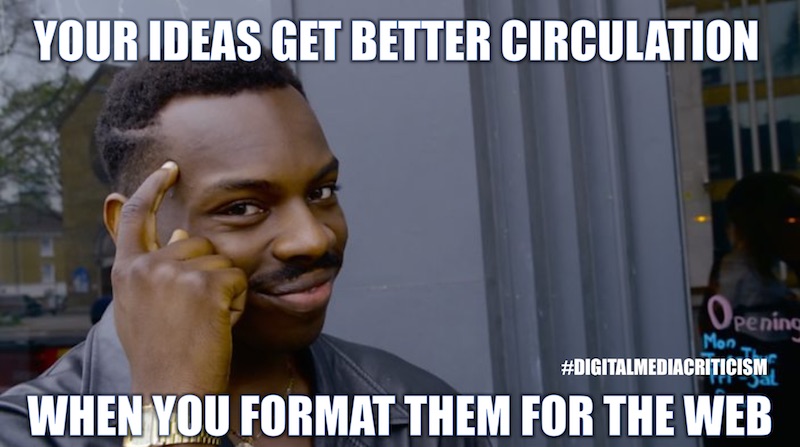
The basic parameters of the assignment are as follows:
- Create a meme using images and/or text relevant to the assigned material. The meme needs to critically engage the material, its format, and appeal to as broad an audience as possible, while suitable for Internet circulation.
- Share a draft of the meme with the class for discussion and feedback.
- Publish revised meme in at least one one social network, using a hashtag defined by the class.
Discussing drafts of the memes in class is an essential part of the activity, not only to explore and offer feedback on how the work or topic is engaged by the meme, but to discuss potentially offensive image and language choices. Publication is also important, because it allows the students’ work to circulate and inspire others to share, remix, or use memes for critical engagement. For this purpose, I recommend that students use a common hashtag (such as #DigitalMediaCriticism, or #HamletMemes) that creates context for the memes and allows others to discover similarly themed memes.
This activity can be as simple as having students respond to assigned readings with memes that engages their ideas. It can also be more elaborate, such as the two activities outlined below:
Hamlet Memes
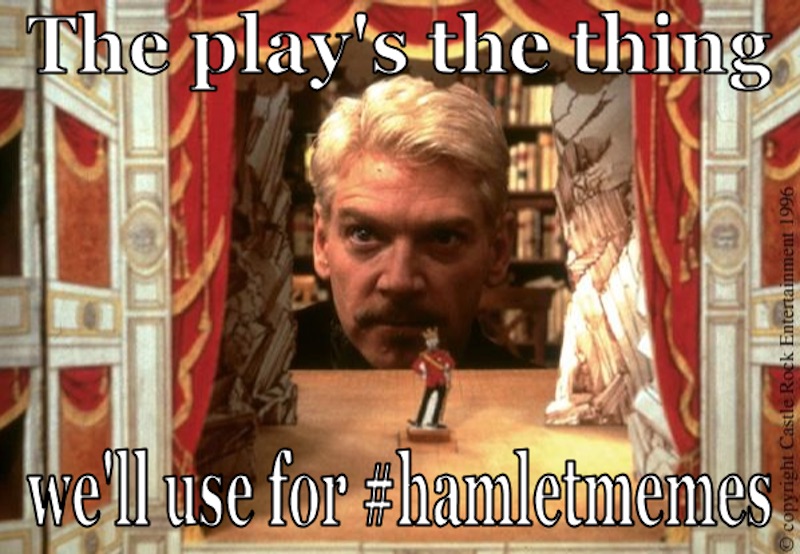
The goal of this set of activities is to get students to pay close attention to the language, cinematic, and television interpretations of Hamlet as the foundation for having a critical response to the work. This was taught in the context of a first year Honors English course at University of Puerto Rico: Mayagüez (UPRM).
- Class reads and discusses Hamlet.
- Divide class into 5 groups and assign a Hamlet adaptation to each (I used: Olivier 1948, Zeffirelli 1990, Branagh 1996, Almereida 2000, and Doran 2009).
- Subdivide each group so students cover each of the 5 acts in the play.
- Create a meme using: a still image from the assigned film, text from the assigned act, and (optional) other text. There are many tools to create memes online.
- Share, discuss in class, and revise memes.
- Publish on Twitter with #HamletMemes hashtag on the following schedule: Act I on Monday, Act II on Tuesday, and so on.
Their initial response?
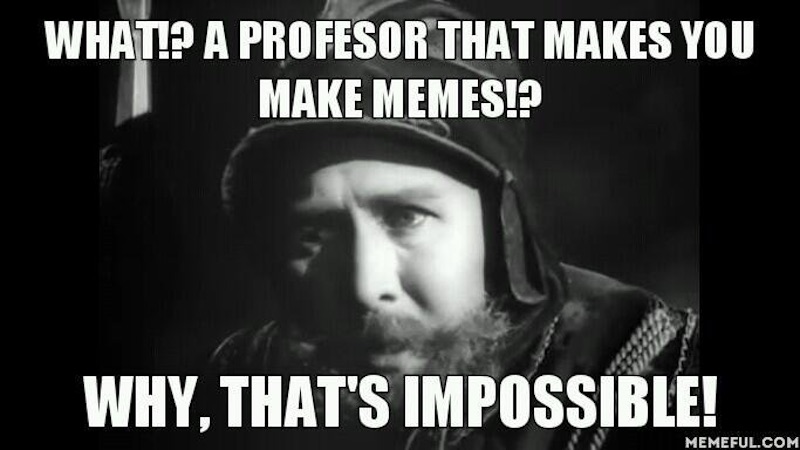
As students developed their memes, however, they found that they were making insightful interpretations of the play that revealed an easily underestimated critical engagement with the materials with which they were working. The compiled tweets, organized by acts, are available in this PDF file and can be found with the #HamletMemes hashtag on Twitter. The memes by themselves are often works in progress, but the discussion around them allowed us to unpack tensions between characters, themes, and other ways to understand the play and its adaptations.
Ultimately, it was a productive approach to critically engage Hamlet with an activity that was accessible and entertaining. The students were very engaged with the activity from the outset, and worked enthusiastically through a series of activities that invited them to pay close attention to the text and the film visuals to create their memes. As they fine-tuned drafts of their memes for publication, they also learned valuable lessons about the potential connotations of their word and image choices when circulated in social media networks, where they would be read in very different contexts.
The Waste Land Memes

This activity was more open because it allowed me and my students to place T. S. Eliot’s famous Modernist poem in conversation any images or existing memes. Here’s a basic description of the assignment, as implemented in my Spring 2016 Modern Poetry class.
- Assign and discuss The Waste Land.
- Divide class into 5 groups and assign a section from the poem to each.
- Create a meme using:
- An image of your choice.
- Some text from the poem.
- Your own text (optional).
- Share, discuss in class, and revise memes over 2 class periods.
- Publish on Twitter with #WasteLandMemes hashtag.
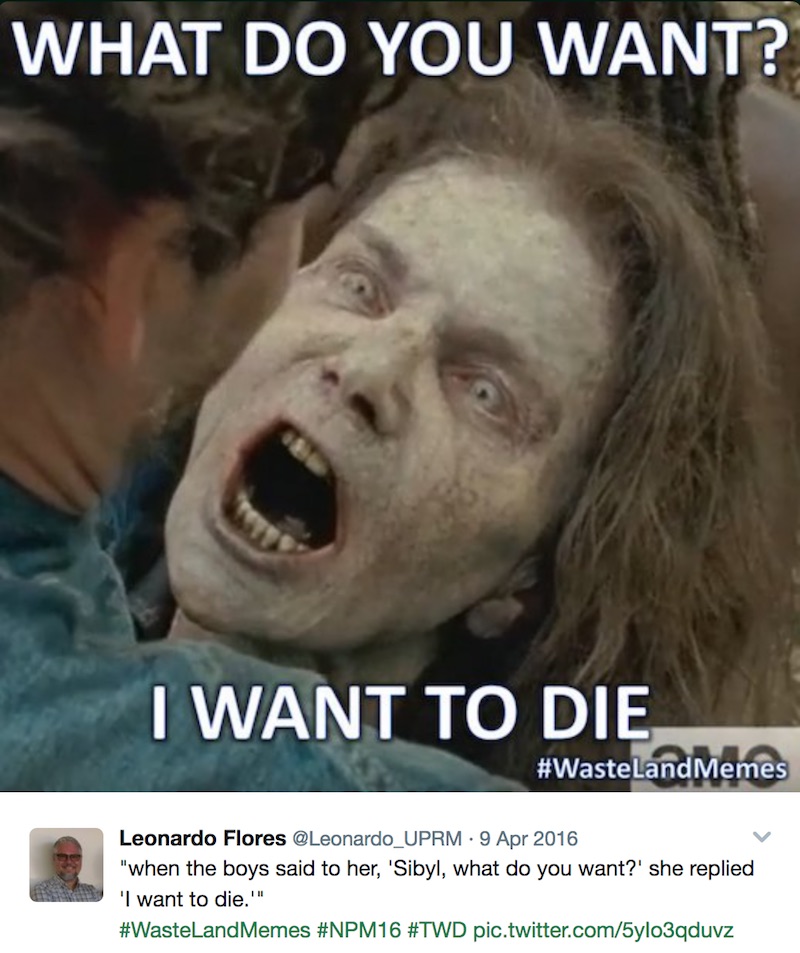
With this meme, I sought to juxtapose Sybil’s agony with that of a zombie, whose body continues to decay as it continues to be active in what becomes a cruel mockery of life. In the scene I took the still image from, a son confronts the zombified body of his mother, and completes the death of her consciousness and personality by destroying her body, fittingly by stabbing her in the brain. Sybil is trapped in a shrinking, aging, deathless body with a perfectly clear awareness of her situation and seeks oblivion-- a narrative that sets the tone in its epigraph for the world T.S. Eliot sought to depict in this poem.
To connect a poem published in 1922 with contemporary popular culture makes a powerful argument for its relevance in contemporary culture. The expressive intensity, themes, and language compression that characterize poetry makes it well suited for excerpts to be placed in conversation with an image. This exercise is particularly suitable for a Modernist poem such as The Waste Land, which favors fragmentation, images, and juxtaposition in its poetics.
The activity and social media campaign happened in April 2016, during National Poetry Month, which drew attention on Twitter and encouraged others to join the meme making activity, such as Prof. Daniel Jung from the University of Bergen in Norway (see figure 5).
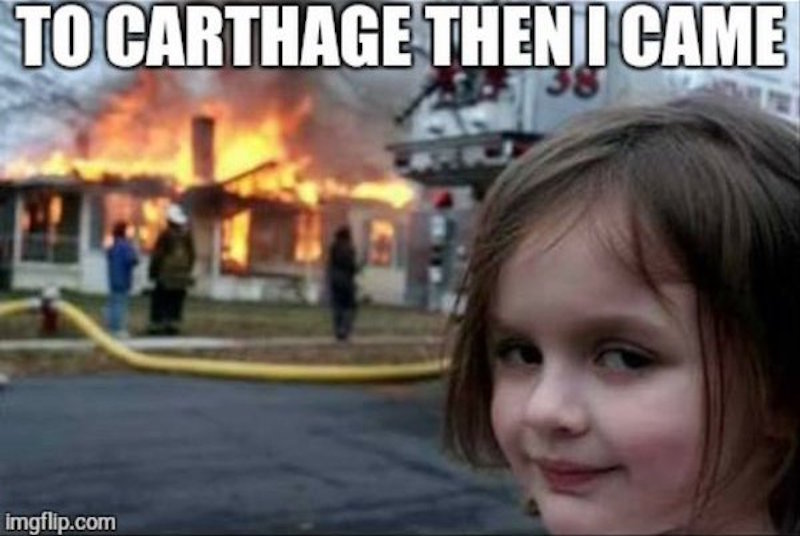
Final Considerations
The Internet is full of meme creating tools and students may already have their favorites. Ask them and they will have plenty to share. A useful resource to understand some of the history and context for established memes is Know Your Meme (http://knowyourmeme.com/).
The popularity of image macro and other kinds of memes are an indicator that multimodality has gained ground as a means for contemporary communication. New generations of students are increasingly comfortable with writing on images rather than on the blank page (both printed and virtual) that we have inherited from print culture. To have students create critical memes forms a bridge between the multimodal present and future of online communication and the unimodal past of print based writing genres. When we ask students to respond to academic content with memes, we are not only opening ourselves up to their ideas, but also to their Internet vernacular. And that creates a productive and humorous space for everyone involved to learn.
Works Cited
Feliciano, Guillermo (@guillermo0320). “Hamlet, Act [1] #hamletmemes #engl3212 #elit.” February 3, 2014. 4:09 pm. Tweet.
Flores, Leonardo (@Leonardo_UPRM). “when the boys said to her, 'Sibyl, what do you want?' she replied 'I want to die.'” #WasteLandMemes #NPM16 #TWD.” April 9, 2016. 10:39 am. Tweet.
Flores, Leonardo (@Leonardo_UPRM). “The play's the thing / we'll use for #hamletmemes” All day today, Hamlet, Act II. #english3212 #elit #digped.” February 4, 2014. 8:22 am. Tweet.
Jung, Daniel (@whatqnavry). “#WasteLandMemes.” April 11, 2016. 6:22 am. Tweet.